The EconomyHousing: the economy’s soaring starSales of single-family new homes surpassed the 1.0 million-unit mark in May, reaching a record high in the life of the series that began in January 1963. This was an 8.1 percent rise from April and a whopping 16.3 percent above year ago levels. Existing home sales edged down 0.3 percent in May but at a 5.75 million-unit rate are still near their peak reached only a few months ago. Sales posted healthy gains in both April and May. The chart below shows a 3-month moving average of home sales, smoothing out their sharp month-to-month fluctuations. The 3-month average shows a slight dip in April and May as sales edged lower from their stratospheric heights of January and February when unseasonably warm weather helped to boost sales. Nevertheless, there is no question that the housing market remained robust during the spring, soaring above the already strong pace registered in the past couple of years. 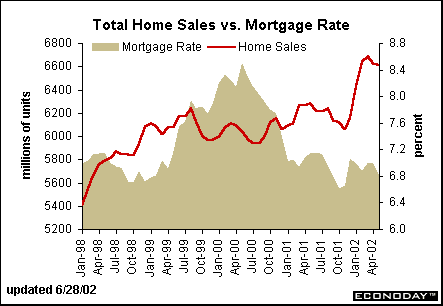
Oddly enough, economists and Fed policymakers indicated that the economic recovery would be soft in 2002 because the two main drivers of early stage growth – housing and motor vehicle sales – would not be able to sustain their 2001 pace. In fact, the housing market continues to confound analysts. Many economists are now suggesting that consumers are investing in housing because the stock market is in the tank. Home prices are appreciating rapidly – well above the inflation rate and certainly better than current returns in the equity market. Furthermore, home appreciation coupled with falling mortgage rates have led to frequent refinancing which in turn gives homeowners additional funds to purchase second homes. Some are investing in vacation homes while others are looking at income properties. Many questions are developing among analysts. How long can the housing boom last? Is it a bubble? The Wall Street Journal has published several articles about investing in housing during this period, including some focusing on regional markets. They cited analysts who believed that the housing bubble was ready to burst in several cities where prices have been particularly frothy the past couple of years. In all things housing, remember the adage “location, location, location.” Consumers spend in moderationPersonal income rose 0.3 percent in May, just a tick higher than last month, but the two months combined was well below the first quarter average. At the same time, personal consumption expenditures edged down 0.1 percent in May, dampened by a sharp drop in durable goods spending (motor vehicle sales), but also by a decline in nondurable goods expenditures. Both income and consumption are still higher than year ago levels, but income growth is now stronger than spending growth for a change. Consequently, the personal savings rate has risen from its low posted in the fourth quarter. Indeed, the personal savings rate has been higher over the past 12 months ending in May relative to the previous 12 months. Consumers tend to spend less and save more during economic recessions and the early stages of recovery. 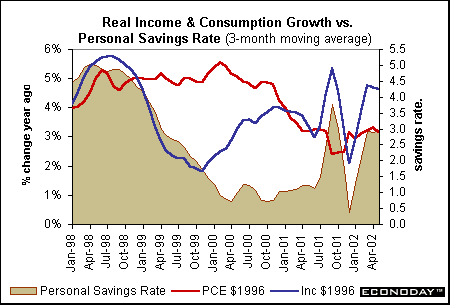
Consumers aren’t as optimistic as they were a couple of years ago, although confidence has certainly picked up from the post-September 11 low. Both the Conference Board’s consumer confidence index and the University of Michigan’s consumer sentiment index dipped in June from May – probably in response to the stock market collapse. 
Upward trend in manufacturingNew orders for durable goods rose 0.6 percent in May after a modest 0.4 percent gain in April. While orders managed to post a yearly gain in April, they fell back in May to post a 1.6 percent decline from a year earlier. Nevertheless, nondefense capital goods orders continue to improve on both a year-over-year and month-to-month basis. In May, nondefense capital goods orders jumped 3.3 percent after a 1.4 percent gain in the previous month. New orders for electrical equipment and machinery were down in May, but primary metals, fabricated metals, computers & electronics and even transportation equipment all posted gains for the month. No one expects capital spending to trigger a healthy recovery this year, but at least the trend is starting to improve. 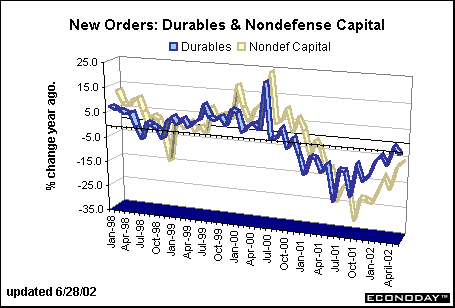
The NAPM-Chicago index, which measures manufacturing activity in the Chicago area, dipped to 58 in June, but the overall level remains pretty healthy. Last month the ISM index didn’t rise as rapidly as the Chicago index; perhaps it won’t decline as fast in June either. The ISM index will be reported on Monday. 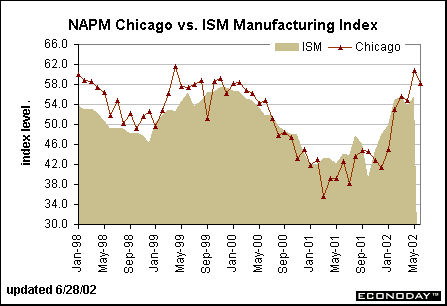
Old news but good newsThe Commerce Department’s second revision for first quarter GDP shows a 6.1 percent rate of growth, faster than the two previous estimates. Consumer spending was revised up slightly, but larger upward revisions were recorded for business investment and net exports. After all is said and done, the slight upward revision to first quarter GDP is not very meaningful to market players because it is old news and reveals nothing about the future. Most economists are already predicting a much slower rate of growth (closer to 2.5 percent) for the second quarter. 
Corporate profits were also revised slightly higher for the first quarter. After-tax profits were up 1.4 percent (quarterly rate) in the first quarter from the fourth quarter. On a year-over-year basis, profits were down 16.9 percent, a smaller decline than the two previous quarters. The chart below compares yearly changes in after-tax profits to the Dow Jones Industrials. The two series tend to move in the same direction over time (although not necessarily by the same magnitude). It had looked as if the Dow was beginning to show signs of improvement – until the outlook for second quarter results weakened. But profits don’t seem to bounce around as much as the Dow, thus the beginnings of the upward trend in after-tax profits could actually stick. 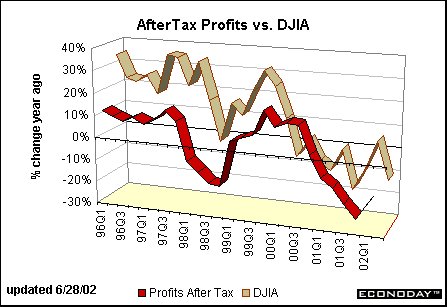
|